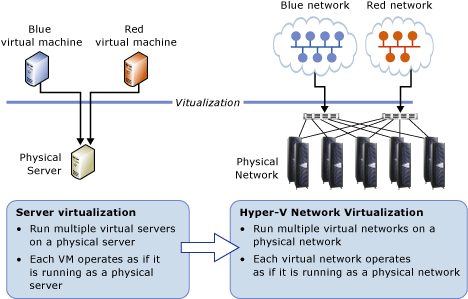VMware or Microsoft? Evaluating Hyper-V Network Virtualization as an alternative to VMware NSX
Network Virtualization, and Software-Defined Networking (SDN) at-large, have been getting a lot of attention recently. After reviewing the network traffic patterns in heavily virtualized datacenters, many IT Pros are beginning to realize that a substantial portion of datacenter network traffic is occurring between virtual machines running on the same virtualization host. In addition, organizations are beginning to evaluate options for defining network-level isolation between virtualized subnets in a manner that provides greater scalability and easier management than a traditional VLAN approach.
Based on this, it makes sense that the networking industry is moving towards bringing layer-3+ networking capabilities directly into the hypervisor. Essentially, network virtualization allows us to abstract routing and switching from a physical network infrastructure, extending benefits similar to what we’ve realized with server workloads via server virtualization.
At VMworld recently, IT Pros were initially impressed with the new network virtualization capabilities that VMware demonstrated in their early pre-release version of the VMware NSX product, based largely on the VXLAN and STT overlay protocols and code from their previous Nicira acquisition. But, after walking away from the excitement of a big trade show event and pondering network virtualization as it pertains to their environment in more detail, I’ve also heard some early concerns expressed with VMware NSX, such as:
- How much does it cost? I’ve already spent quite a bit on vSphere and vCenter, and I’m not sure I have budget for yet another separately licensed virtualization product.
- Is it compatible with what I have? I’ve invested in 3rd party products that replace VMware’s inbox virtual switch, such as the Cisco Nexus 1000V … it doesn’t appear that I can leverage this investment with VMware NSX.
- Why can’t I use vCenter to manage VMware NSX? It seems like every new solution in the virtualization space introduces another new management tool. With each change, I’m expected to shift gears and switch to a new tool for provisioning/managing VMs and virtualized resources.
VMware NSX isn’t expected to be available until later this year, so in the meantime, consider evaluating alternatives for network virtualization that are actually shipping today. In this article, I’ve included a learning roadmap for understanding and evaluating our network virtualization solution, Hyper-V Network Virtualization in Windows Server 2012.
Please check out Keith’s blog for the rest of the article here -
VMware or Microsoft? Evaluating Hyper-V Network Virtualization as an alternative to VMware NSX
-Cheers!
